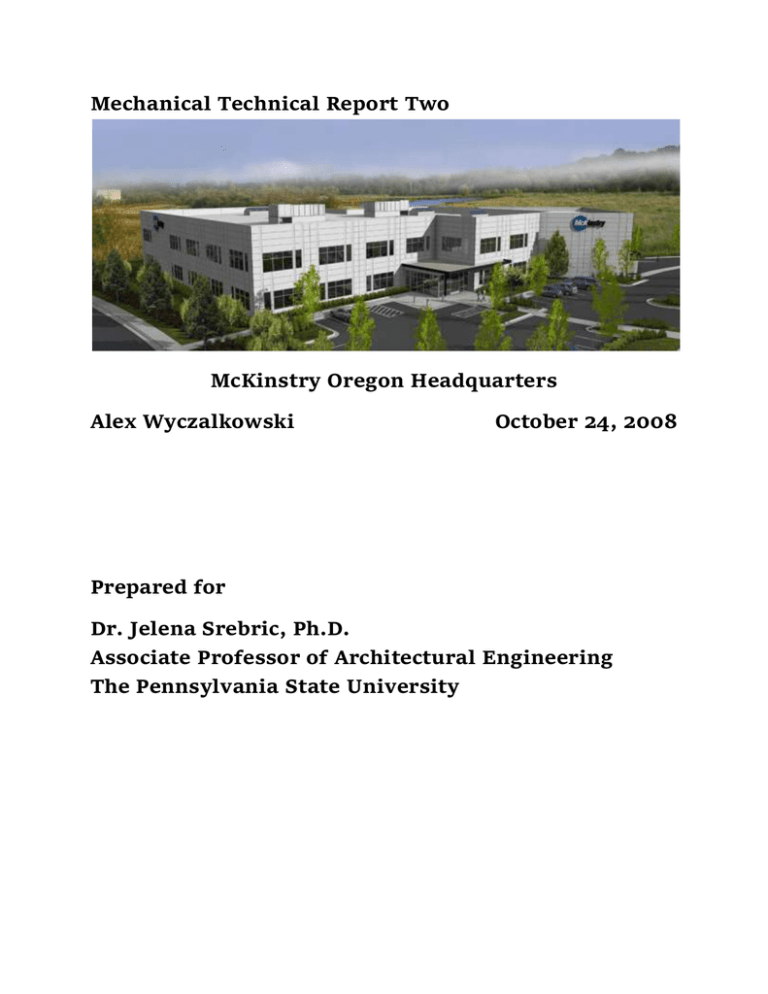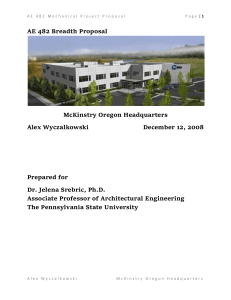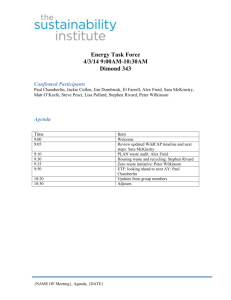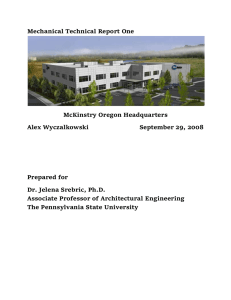Tech Report II
advertisement

Mechanical Technical Report Two McKinstry Oregon Headquarters Alex Wyczalkowski October 24, 2008 Prepared for Dr. Jelena Srebric, Ph.D. Associate Professor of Architectural Engineering The Pennsylvania State University Technical Report 1 Page |2 Table of Contents 1 Executive Summary 3 2 Building and Mechanical System Overview 4 3 Previous Energy Models 6 4 Energy Model Input 6 4.1 4.2 6 7 5 Annual Energy Consumption 5.1 5.2 5.3 6 Input Design Loads 8 Airside Systems Waterside Systems Energy Consumption 8 8 11 Annual Operating Costs 12 6.1 6.2 6.3 12 12 13 Utility Rate Analysis Monthly and Annual Costs Annual Cost Breakout 7 Discussion of Results 14 8 References 15 9 Appendix A – Design Document 16 10 Appendix B – Portland Design Conditions 17 11 Appendix C – Load Calculation Printout 18 Alex Wyczalkowski McKinstry Oregon Headquarters Technical Report 1 1 Page |3 Executive Summary McKinstry Oregon Headquarters is a 50,590 square foot, 2 story office building. It began construction in March 2008 and is scheduled for completion in March 2009. It is located in Northeast Portland, overlooking the Columbia River. The building contains 2 floors of offices, as well as a full kitchen, showers, and a small weight room for employees. There is also a large warehouse at the west end of the building which is not ventilated. The energy model in this report is the first such publication on McKinstry Oregon Headquarters. Over the summer of 2008, Alexander Wyczalkowski worked for McKinstry in their Portland Office and created an energy model for the building. The model used in this report is virtually the same exact model. Design loads for the building are 18.03 BTU/(hr*sf) for cooling and 19.55 BTU/(hr*sf) for heating. Tables can be found in Section 4.2. The most significant loads on the building are internal. A lighting load of .81W/sf and equipment load of .5W/sf add both energy consumption as well as sensible heat to the building which needs to be cooled. A population of 1 person/200sf adds latent and sensible load. Exterior loads are also a factor, although the weather in Portland is generally mild, and only about 30% of the façade is glass. A full description of loads and assumptions is located in Section 4.1. Table 5.3.1 shows total electric consumption for the building to be 331,540 kWh per year. In addition, domestic hot water consumes 516 therms/year. This produces an annual operating cost of $27,776. Calculations can be found in Section 6.1. Breaking down costs, the largest percent of costs comes from lighting loads and equipment loads. This is caused by two factors, a mild climate, as well as an efficient building design. Cooling costs per square foot are 3.24¢ per year (see Table 6.3.1), and total energy costs per square foot are 54.9¢ per year (Table 6.3.2). This is significantly lower than the average energy use for an office building, according to the ASHRAE Applications Handbook (see References). Alex Wyczalkowski McKinstry Oregon Headquarters Technical Report 1 2 Page |4 Building and Mechanical System Overview McKinstry Oregon Headquarters is a $15.5 million project which is scheduled for completion March 1, 2009. This includes two buildings. The only building of interest is the office building, as the other is simply a warehouse. Costs for the 50,590 square foot office building total $11.1 million dollars. The headquarters is a 2 story office building. The office is laid out in a simple rectangular grid. At the West end of the building a full height 1 story warehouse attaches at a rotated angle. Ware House 4400 sf Vestibule 484 sf Office 23,000 sf per floor N Figure 2.1. Building Footprint The flat, tilt-up concrete walls have vertical and horizontal lines to break the long straight façade. Approximately 30% of the office façade is glazing and windows are double glazed. The base of the building is a reinforced concrete slab (there is no basement). The exterior walls are backed by 3-5/8” metal studs and 3.5” batt insulation. A built-up roof with 3” rigid insulation and 1.5” metal decking tops off the structure. The roof also has several translucent skylights for natural day lighting. The remaining lighting in the building is fairly standard with 100% fluorescent fixtures. Alex Wyczalkowski McKinstry Oregon Headquarters Technical Report 1 Page |5 Figure 2.2. Waterside system, shown in heating mode. See Figure 5.2.1 for cooling mode (McKinstry Design Documents) The central plant of the building is a heat recovery chiller that is used for both heating and cooling. The mechanical system also includes an open loop ground source heat pump. Ground water accepts heat from the condensing water in cooling mode and provides heat to the evaporator water in heating mode. Evaporator side water and condenser side water are piped to the cooling and heating coils in the air handling unit, respectively. A single rooftop AHU (with VFD) distributes air via ducts to the office section of the building. Series VAV boxes with hot water reheats are located throughout the office. Also, an airside economizer can provide cooling on light load days. Two hot water unit heaters keep the warehouse warm in the winter. Heating is provided by the hot water loop and there is no cooling or ventilation. Linear diffusers condition the vestibule at the front of the building. The electric room has a ductless split system ACU for additional cooling. Alex Wyczalkowski McKinstry Oregon Headquarters Technical Report 1 Page |6 3 Previous Energy Models During the summer of 2008, Alexander Wyczalkowski worked as an intern for McKinstry in their Portland office. In August, he completed the energy model for McKinstry Oregon Headquarters. This is the model that will be referenced throughout the report. There were no other energy models built by engineers at McKinstry. 4 Design Load Estimation The following section is an overview of the inputs and assumptions put into the energy model for McKinstry Oregon Headquarters. Any assumptions not listed, such as infiltration and hot water heater insulation, were left as defaults in the program, because specific information was not available for those parameters. 4.1 Input Envelope The energy model is comprised of 4 main areas or zones. Generally the envelope of the building is the same in each area. Table 4.1.1. eQUEST Envelope Assumptions SPACE Warehouse 4375 sf 1st Floor Office 23,715 sf 2nd Floor Office 22,500 sf Atrium 484 sf Floor to Floor Height 34.5’ Floor to Ceiling Height 34’ Roof Construction Floor Construction Wall Construction 6” slab on grade 7”concrete w/ 3.5” batt insul and metal studs 15’ Built up roof with 3” rigid insul above metal decking 2nd floor 14.5’ 6” slab on grade with carpet Same as warehouse 19.5’ 19’ Same as warehouse Same as warehouse 14’ 11’ Same as warehouse 2” metal decking with 2.5” concrete topping 6” slab on grade with carpet Alex Wyczalkowski Windows, double pane McKinstry Oregon Headquarters Technical Report 1 Page |7 In addition, doors and windows are key parts of the envelope. The following shows the assumptions used for openings. Openings were placed on the computer model to match plans and elevations. Table 4.1.2. Door and Window Assumptions Door – type 1 Door – type 2 Door – type 3 Windows Skylights Construction Glass – double pane, Low-E Steel – insulated Steel – overhead, uninsulated Glass – double pane, low-E Acrylic, double pane, translucent, 4 total Size Most are 3’x8’ Most are 3’x8’ 10’x14’ Most are 16’x8’ 8’x15’ Loads and Existing Conditions Table 4.1.3. Ventilation, Load Sources and Schedules: OA Ventilation People Equipment Lighting Design Conditions Schedule Value 5,500 CFM 200sf/person .5 W/sf* .81 W/sf Source Mechanical Specs See Appendix A See Appendix A See Appendix A See Appendix B Occupied hours: 6am-6pm, Mon-Fri; Unoccupied Sat,Sun, Holidays *equipment load is shown on the documents as being 1.1W/sf. This was an overestimate to size the AHU. After consulting with engineers, a more accurate estimate for energy consumption is .5W/sf 4.2 Design Loads Table 4.2.1. Energy Model Loads vs Design Document Loads Cooling Peak sf/ton Heating Peak Supply Air at Peak Flow Min Outside Air/person eQUEST model* 18.03 BTU/(hr*sf) 665.5 19.55 BUT/(hr*sf) .82 CFM/sf 33.88 CFM Design Documents NA 503 NA NA 23.09 CFM *See Appendix C for eQUEST printout Alex Wyczalkowski McKinstry Oregon Headquarters Technical Report 1 Page |8 5 Annual Energy Consumption Once loads are found, HVAC systems need to be specified so that efficiencies can be estimated. Section 2 of this report provides an overview of the mechanical systems in The McKinstry Oregon Headquarters. All assumptions from Section 3 are used to find annual energy consumption. See Table 4.1.3 for schedules. 5.1 Air Side Systems There are two main air systems in the building. The first is the main HVAC system, which is described in section 2 of this report. In addition, the warehouse is heated by 2 hot water unit heaters. There is no cooling or ventilation in the warehouse. Table 5.1. Air Side System Assumptions Cooling Source Heating Source System Type Return Air Occupied Setpoints Unoccupied Setpoints Supply Temps Airflow Supply Fan Return Fan Economizer Central HVAC (Office, Atrium) Cooling Coils Hot Water Coils Series VAV w/ Hot water Reheat Ducted Cool: 74F, Heat: 70F Cool: 78F, Heat: 65F Cool: 55F, Heat: 100F Minimum .17cfm/sf, 25%VAV 46.2 BHP, Premium Efficiency, 37,220 CFM, 20.7% OA, VSD .91 BHP Drybulb Temp, High Limit 55F Warehouse None Hot Water Coils Forced Air HW Heaters No ventilation Same Same Heat: 100F Minimum .17cfm/sf .09 BHP Premium Efficiency NA NA 5.2 Water Side Systems CHW Plant The Chilled water plant in the building consists of 2 chillers. The following are assumptions put into eQUEST for the CHW Plant. Note that heat rejection is actually provided by a ground source heat exchanger. eQUEST does not allow this option, so an efficient cooling tower must be assumed instead. Chiller: Pump Config: Single system pump (1 total), variable flow Head=81ft, flow=285 gpm Chiller size – 123.5 tons, type- hermetic scroll (assume screw) Alex Wyczalkowski McKinstry Oregon Headquarters Technical Report 1 Page |9 Chiller efficiency – 70.6kw/123.5 tons= .5717 kw/ton Cooling Tower: Head=90ft, flow= 130gpm Control: Load Reset, CHW Min=48F, CHW Max=58F, Demand Operation Figure 5.2.1. Waterside System. Shown in cooling mode. See Figure 2.2 for heating mode (McKinstry Design Documents) HW Plant Hot water for the heating coils comes from the condenser side of the 2 heat recovery chillers. The ground water acts as the low temperature heat sink in the heat pump cycle as it warms the evaporator side refrigerant in the chiller. (see figure 2.2). For the eQUEST model, the closest approximation to this system is a boiler with an efficiency equal to the COP of the heat pump. Boiler: efficiency=410%, electric demand=94.3kW, output=1303 kBTUh Loop Flow: variable, head=90ft, flow=130gpm Control: Load Reset, HW Max=120F, HW Min=100F Alex Wyczalkowski McKinstry Oregon Headquarters Technical Report 1 P a g e | 10 DHW Equipment Domestic Hot Water is entirely separate from the HVAC system. It is heated by a gas furnace, the only natural gas used in the building. The following assumptions were put into eQUEST Assumptions: Natural Gas Heater, storage, 95% efficient, 199 kBTUh, 100 gal tank, inlet=ground temp, 120F supply Figure 5.2.2. eQUEST printout of Waterside System. Note discrepancy between actual system (Figure 5.2.1) Alex Wyczalkowski McKinstry Oregon Headquarters Technical Report 1 P a g e | 11 5.3 Energy Consumption Figure 5.3.1. Electric consumption, gas consumption, and electricity breakdown Table 5.3.1. Electric and gas consumption =(Therms x10) Alex Wyczalkowski McKinstry Oregon Headquarters Technical Report 1 P a g e | 12 6 Annual Energy Costs 6.1 Utility Rate Analysis Electricity is provided to the building by Portland General Electric (PGE). The rate code is “PGE 83S 3P N-TOU Lrg N-Res Elec”. Essentially this means it is large non-residential electric. The following is a general formula for charges: Monthly Charge = [$25 + $.05298*(kWh usage) + $2.27*(kW demand)]/.8 Where .8 is the Power Factor adjustment. Natural Gas is provided by Northwest Natural. The code is “NW Natural-OR 3-Comm Uniform”. The following is a general formula for charges: Monthly Charge = $8 + $1.198/therm 6.2 Monthly and Annual Costs Figure 6.2.1. Monthly Energy Costs Alex Wyczalkowski McKinstry Oregon Headquarters Technical Report 1 P a g e | 13 6.3 Annual Cost Breakout Table 6.3.1. Annual Cost Breakout. Yearly Energy Use (kWh) Cooling 15,210 Heat Rejection 9,600 Space Heating 41,790 Ventilation&Fans 51,860 Pumps & Aux 19,820 Lighting 118,780 Misc Equip 74,470 Dom Hot Water 51,590 (kBTU) 1 2 Max Demand (kW) 40.3 11.5 101.4 29.6 11.5 35.8 22.2 20.14 (kBTU/h) Cost To Operate, annual ($)1 1,497 797 4,014 4,151 1,485 9,029 5,642 714 Cost per square foot, annual (¢) 3.242 1.732 7.93 8.20 2.93 17.85 11.15 1.41 Cost to Operate = ∑Monthly Costs, Jan-Dec; see Excel File: Operating Costs.xlsx Square footage does not include Warehouse The following table compares the usage breakdown of the eQUEST model, versus an average Office building. The percentages should approximately match between the two columns. If they were significantly different, this could be a sign of an error in the energy model. Table 6.3.2. Cost Breakdown. eQUEST model compared to ASHRAE* Cooling Heat Rejection Space Heating Ventilation&Fans Pumps & Aux Lighting Misc Equip Dom Hot Water Total Cost per sf eQUEST Model, % of total cost 5.48 2.92 14.7 15.2 5.43 33.0 21.2 2.06 $.549 ASHRAE*, % of total usage 9.36 25.0 5.34 28.9 22.4 8.95 $1.51 *Energy End Use for Office Building, 1995 Commercial Building Energy Consumption (Applications Handbook) Alex Wyczalkowski McKinstry Oregon Headquarters Technical Report 1 P a g e | 14 7 Discussion of Results Overall, McKinstry Oregon Headquarters is a fairly efficient building. Although there are large internal loads in the building with lighting and equipment, the building is fairly well insulated and has an efficient mechanical system. One key note to make about loads is the comparison between sf/ton. In the design documents, sf/ton was 503. In the eQUEST model, this value is 666. These numbers are consistent with expectations because the design documents were over conservative to oversize the mechanical systems. Another interesting comparison is minimum OA/person. The design documents only spec 23 CFM, where as the energy model uses 34 CFM. Utility Rates average to be about $.08 per kWh and $1.40 per therm. These numbers are what should be expected for Oregon. When breaking down monthly costs, bills are relatively flat, although peak slightly in the summer and winter months, as seen in figure 6.2.1. Table 6.3.1 shows a yearly breakdown by usage type. Most notably, cooling and heat rejection cost comes to 4.97 ¢ per sf annually. Table 6.3.2 compares the usage breakdown of the eQUEST model, versus an average Office building. The numbers are fairly similar. Several discrepancies on the eQUEST model are lower cooling and heating percentages, as well as higher pump and miscellaneous operation. The low cooling and heating loads could be due to the mild climate in Portland. High pump loads could be due to the ground source heat pump, which has to pump water from several hundred feet underground. Alex Wyczalkowski McKinstry Oregon Headquarters Technical Report 1 P a g e | 15 8 References ASHRAE. 2005, ANSI/ASHRAE, Portland Design Conditions. American Society of Heating Refrigeration and Air Conditioning Engineers, Inc., Atlanta, GA. 2007 ASHRAE. 2003. ASHRAE Handbook, HVAC Applications. Section 35.8, Table 2A. American Society of Heating Refrigeration and Air Conditioning Engineers, Inc., Atlanta, GA. 2003 McKinstry. 2008. Design Documents. McKinstry, Seattle, WA. 2008 Wozniak, Aaron. 2008. Personal Communication. Portland, OR. 2008 Alex Wyczalkowski McKinstry Oregon Headquarters Technical Report 1 9 Alex Wyczalkowski P a g e | 16 Appendix A – Design Document McKinstry Oregon Headquarters Technical Report 1 10 P a g e | 17 Appendix B – Ventilation Rate Calculations Alex Wyczalkowski McKinstry Oregon Headquarters Technical Report 1 11 Alex Wyczalkowski P a g e | 18 Appendix C – Load Calculation Printout McKinstry Oregon Headquarters




